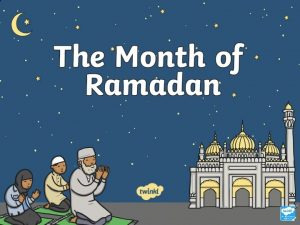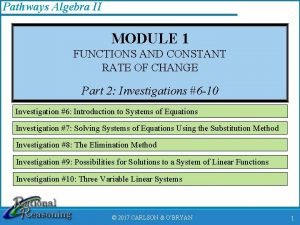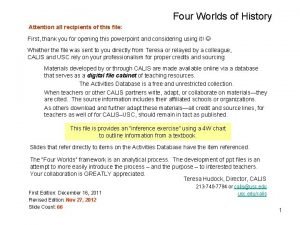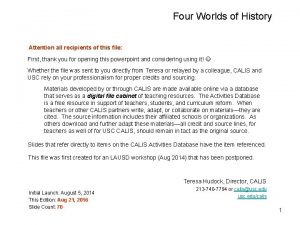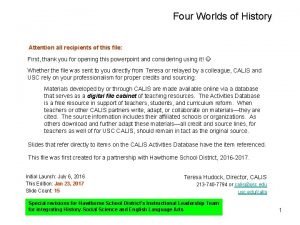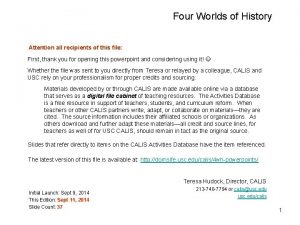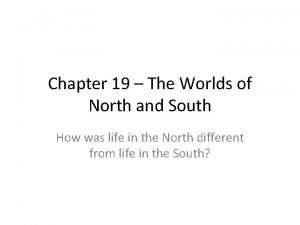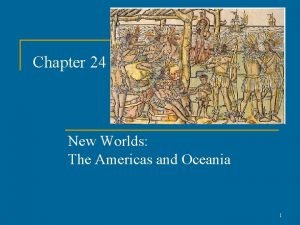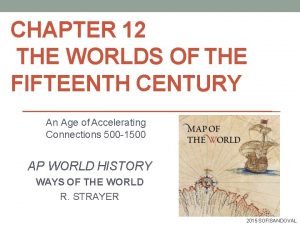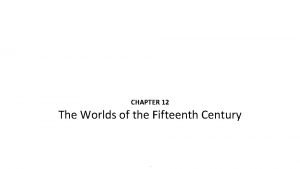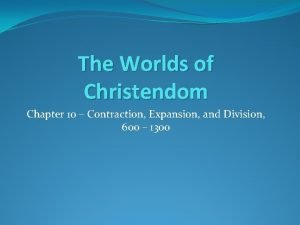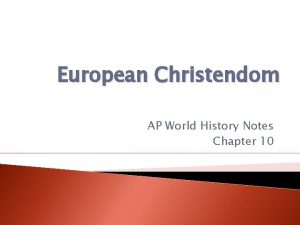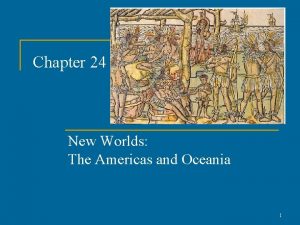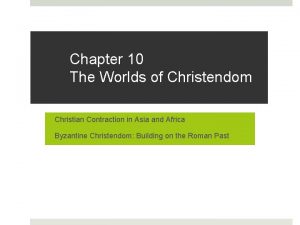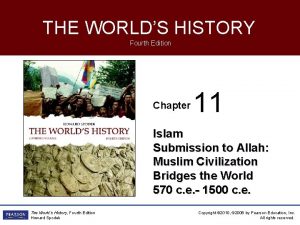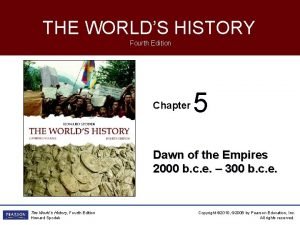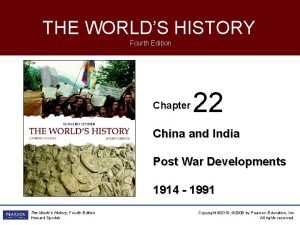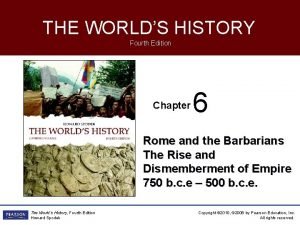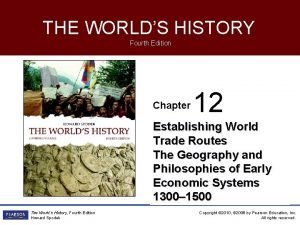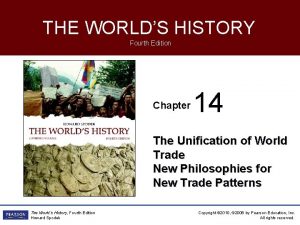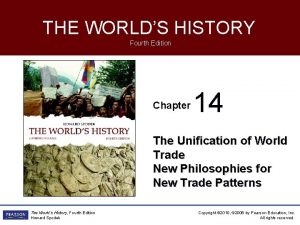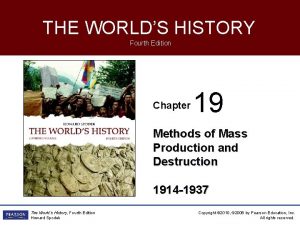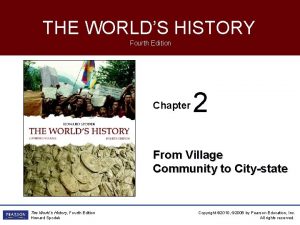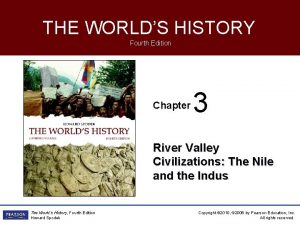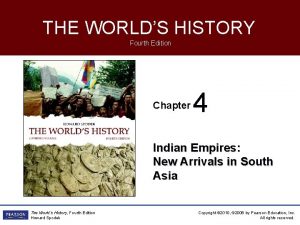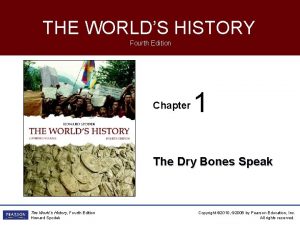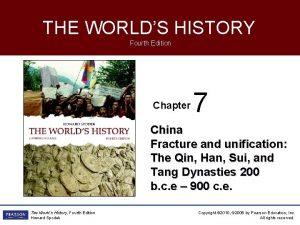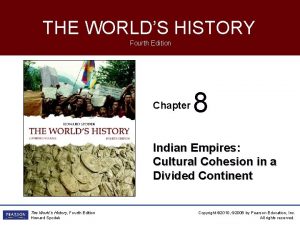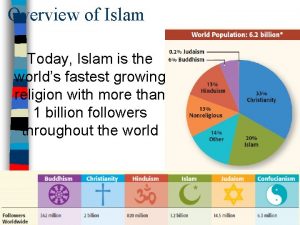THE WORLDS HISTORY Fourth Edition Chapter 11 Islam







![The Origins of Islam • The Five Pillars of Islam [cont. ] – Jihad The Origins of Islam • The Five Pillars of Islam [cont. ] – Jihad](https://slidetodoc.com/presentation_image/4a5e0681e6f19fb8d287e275a6e36df1/image-8.jpg)

![The Origins of Islam • Responses to Muhammad [cont. ] – The Hijira and The Origins of Islam • Responses to Muhammad [cont. ] – The Hijira and](https://slidetodoc.com/presentation_image/4a5e0681e6f19fb8d287e275a6e36df1/image-10.jpg)
![The Origins of Islam • Responses to Muhammad [cont. ] – Muhammad Extends His The Origins of Islam • Responses to Muhammad [cont. ] – Muhammad Extends His](https://slidetodoc.com/presentation_image/4a5e0681e6f19fb8d287e275a6e36df1/image-11.jpg)
![The Origins of Islam • Responses to Muhammad [cont. ] – Connections to Other The Origins of Islam • Responses to Muhammad [cont. ] – Connections to Other](https://slidetodoc.com/presentation_image/4a5e0681e6f19fb8d287e275a6e36df1/image-12.jpg)



![Successors to the Prophet • Religious Conflict and the Sunni-Shi’a Division [cont. ] – Successors to the Prophet • Religious Conflict and the Sunni-Shi’a Division [cont. ] –](https://slidetodoc.com/presentation_image/4a5e0681e6f19fb8d287e275a6e36df1/image-16.jpg)



![Successors to the Prophet • The Weakening of the Caliphate [cont. ] – The Successors to the Prophet • The Weakening of the Caliphate [cont. ] – The](https://slidetodoc.com/presentation_image/4a5e0681e6f19fb8d287e275a6e36df1/image-20.jpg)


![Successors to the Prophet • The Weakening of the Caliphate [cont. ] – Mongols Successors to the Prophet • The Weakening of the Caliphate [cont. ] – Mongols](https://slidetodoc.com/presentation_image/4a5e0681e6f19fb8d287e275a6e36df1/image-23.jpg)





![Spiritual, Religious, and Cultural Flowering • Islam Reaches New Peoples [cont. ] – Southeast Spiritual, Religious, and Cultural Flowering • Islam Reaches New Peoples [cont. ] – Southeast](https://slidetodoc.com/presentation_image/4a5e0681e6f19fb8d287e275a6e36df1/image-29.jpg)

![Spiritual, Religious, and Cultural Flowering • Islam Reaches New Peoples [cont. ] – Sub-Saharan Spiritual, Religious, and Cultural Flowering • Islam Reaches New Peoples [cont. ] – Sub-Saharan](https://slidetodoc.com/presentation_image/4a5e0681e6f19fb8d287e275a6e36df1/image-31.jpg)




![Spiritual, Religious, and Cultural Flowering • Intellectual Achievements [cont. ] – Philosophy § Encountered Spiritual, Religious, and Cultural Flowering • Intellectual Achievements [cont. ] – Philosophy § Encountered](https://slidetodoc.com/presentation_image/4a5e0681e6f19fb8d287e275a6e36df1/image-36.jpg)
![Spiritual, Religious, and Cultural Flowering • Intellectual Achievements [cont. ] – Mathematics, Astronomy, and Spiritual, Religious, and Cultural Flowering • Intellectual Achievements [cont. ] – Mathematics, Astronomy, and](https://slidetodoc.com/presentation_image/4a5e0681e6f19fb8d287e275a6e36df1/image-37.jpg)







![Relations with Non-Muslims • A Golden Age in Spain [cont. ] – Rich hybrid Relations with Non-Muslims • A Golden Age in Spain [cont. ] – Rich hybrid](https://slidetodoc.com/presentation_image/4a5e0681e6f19fb8d287e275a6e36df1/image-45.jpg)

- Slides: 46

THE WORLD’S HISTORY Fourth Edition Chapter 11 Islam Submission to Allah: Muslim Civilization Bridges the World 570 c. e. - 1500 c. e. The World’s History, Fourth Edition Howard Spodek Copyright © 2010, © 2006 by Pearson Education, Inc. All rights reserved.

Islam • Islam means “submission” in Arabic • Story of Muhammad’s life, words, and deeds (hadith) are basis of Islam • Teachings of Quran and of Muhammad’s life are fulfilled in the life of a community (the umma) • Combination of religion and government makes Islam similar to empires The World’s History, Fourth Edition Howard Spodek Copyright © 2010, © 2006 by Pearson Education, Inc. All rights reserved.

The World’s History, Fourth Edition Howard Spodek Copyright © 2010, © 2006 by Pearson Education, Inc. All rights reserved.

The World’s History, Fourth Edition Howard Spodek Copyright © 2010, © 2006 by Pearson Education, Inc. All rights reserved.

The World’s History, Fourth Edition Howard Spodek Copyright © 2010, © 2006 by Pearson Education, Inc. All rights reserved.

The Origins of Islam • The Prophet: His Life and Teaching – Visited by Angel Gabriel in 610 C. E. at age forty; visits continued for twenty years – After Muhammad’s death, his words were memorized and written down as the Quran – Quran regarded as absolute, uncorrupted word of God – Discovery of paper and printing speeds the spread of the Quran The World’s History, Fourth Edition Howard Spodek Copyright © 2010, © 2006 by Pearson Education, Inc. All rights reserved.

The Origins of Islam • The Five Pillars of Islam – Declaring the Creed – Praying five times a day facing Mecca – Giving alms to the poor – Fasting each day during Ramadan – Making a hajj (pilgrimage to Mecca) The World’s History, Fourth Edition Howard Spodek Copyright © 2010, © 2006 by Pearson Education, Inc. All rights reserved.
![The Origins of Islam The Five Pillars of Islam cont Jihad The Origins of Islam • The Five Pillars of Islam [cont. ] – Jihad](https://slidetodoc.com/presentation_image/4a5e0681e6f19fb8d287e275a6e36df1/image-8.jpg)
The Origins of Islam • The Five Pillars of Islam [cont. ] – Jihad (sacred struggle) sometimes called the “sixth pillar” § For some it means the extension of Muslim lands (dar al-Islam) § For others it means personal struggle – Faithful Muslims will attain paradise – Many parallels among Islam, Judaism, and Christianity The World’s History, Fourth Edition Howard Spodek Copyright © 2010, © 2006 by Pearson Education, Inc. All rights reserved.

The Origins of Islam • Responses to Muhammad – Residents of Mecca found his moral teachings too demanding and questioned his mental stability – Meccan Christians and Jews did not believe their monotheism needed purification – Death of many of first-generation followers caused remainder to relocate The World’s History, Fourth Edition Howard Spodek Copyright © 2010, © 2006 by Pearson Education, Inc. All rights reserved.
![The Origins of Islam Responses to Muhammad cont The Hijira and The Origins of Islam • Responses to Muhammad [cont. ] – The Hijira and](https://slidetodoc.com/presentation_image/4a5e0681e6f19fb8d287e275a6e36df1/image-10.jpg)
The Origins of Islam • Responses to Muhammad [cont. ] – The Hijira and the Islamic Calendar § Muhammad invited to Medina to adjudicate dispute § Flight to Medina (622 C. E. ) known as hijira and is Year One of the Islamic calendar § Converted many in Medina but not Jews § Created religious community (umma) interlocked with Islamic government (dar al Islam) § Formulated legal code based on the Quran The World’s History, Fourth Edition Howard Spodek Copyright © 2010, © 2006 by Pearson Education, Inc. All rights reserved.
![The Origins of Islam Responses to Muhammad cont Muhammad Extends His The Origins of Islam • Responses to Muhammad [cont. ] – Muhammad Extends His](https://slidetodoc.com/presentation_image/4a5e0681e6f19fb8d287e275a6e36df1/image-11.jpg)
The Origins of Islam • Responses to Muhammad [cont. ] – Muhammad Extends His Authority § Warfare between early Muslims and Mecca with Muhammad ultimately winning in 630 C. E. § Muslims destroyed Meccan idols, captured Ka’aba, and turned it and its sacred black rock into Islmaic shrine § By time of Muhammad’s death in 632, Muslims were well on their way to creating an Arabia-wide federation dedicated to faith and the political structure of Islam The World’s History, Fourth Edition Howard Spodek Copyright © 2010, © 2006 by Pearson Education, Inc. All rights reserved.
![The Origins of Islam Responses to Muhammad cont Connections to Other The Origins of Islam • Responses to Muhammad [cont. ] – Connections to Other](https://slidetodoc.com/presentation_image/4a5e0681e6f19fb8d287e275a6e36df1/image-12.jpg)
The Origins of Islam • Responses to Muhammad [cont. ] – Connections to Other Monotheistic Faiths § Muslims claim Abraham (Hebrew) as the first Muslim and see Jews, Christians, and Muslims as “children of Abraham” § Accept earlier prophets including Jesus as people whose ideas were later corrupted by followers § Believe there will be no further revelations § Christians and Jews allowed to practice their faith but were subject to a special tax The World’s History, Fourth Edition Howard Spodek Copyright © 2010, © 2006 by Pearson Education, Inc. All rights reserved.

Successors to the Prophet • Problem of successor to Muhammad initially met by election of close associates as caliph • Military successes spread Islam: Damascus in 636 and Jerusalem in 638 • Administered conquered lands with garrison towns which were unstable • Islam an empire or a religion? The World’s History, Fourth Edition Howard Spodek Copyright © 2010, © 2006 by Pearson Education, Inc. All rights reserved.

The World’s History, Fourth Edition Howard Spodek Copyright © 2010, © 2006 by Pearson Education, Inc. All rights reserved.

Successors to the Prophet • Religious Conflict and Sunni-Shi’a Division – Should caliph be from Muhammad’s family [Shi’ites] or from Ummayid clan of recent caliphs [Sunni] ? – Two Shi’a caliphs were assassinated and war broke out (680); eleven Shi’a imams or caliphs were assassinated in all – Shi’a wanted imam to model religious principles; opponents saw post as political The World’s History, Fourth Edition Howard Spodek Copyright © 2010, © 2006 by Pearson Education, Inc. All rights reserved.
![Successors to the Prophet Religious Conflict and the SunniShia Division cont Successors to the Prophet • Religious Conflict and the Sunni-Shi’a Division [cont. ] –](https://slidetodoc.com/presentation_image/4a5e0681e6f19fb8d287e275a6e36df1/image-16.jpg)
Successors to the Prophet • Religious Conflict and the Sunni-Shi’a Division [cont. ] – Hereditary line of Muhammad’s family ended with the disappearance of the “twelfth imam” – Office of caliph no longer exists but dispute continues – 83% of Muslims are Sunni today The World’s History, Fourth Edition Howard Spodek Copyright © 2010, © 2006 by Pearson Education, Inc. All rights reserved.

Successors to the Prophet • Umayyad Caliphs Build an Empire – Urban life eroded tribal life, created class differences, and mixed Arab and non-Arab elites – Used Byzantine and Persian governing practices – Revolts from 740 s onward but some military victories including Talas River (751), which halted Chinese advance westward The World’s History, Fourth Edition Howard Spodek Copyright © 2010, © 2006 by Pearson Education, Inc. All rights reserved.

Successors to the Prophet • The Third Civil War and the Abbasid Caliphs – From northern Iran Abbasids claimed caliphate in 750 – Continued imperial quest of the Umayyids – Abbasids successfully ruled empire for a century with centralized administration and good local relations The World’s History, Fourth Edition Howard Spodek Copyright © 2010, © 2006 by Pearson Education, Inc. All rights reserved.

Successors to the Prophet • The Weakening of the Caliphate – Abbasids faced succession issues and civil war – Began to rely more on slave troops – Civilian administration became more corrupt – Tax collection became exploitive The World’s History, Fourth Edition Howard Spodek Copyright © 2010, © 2006 by Pearson Education, Inc. All rights reserved.
![Successors to the Prophet The Weakening of the Caliphate cont The Successors to the Prophet • The Weakening of the Caliphate [cont. ] – The](https://slidetodoc.com/presentation_image/4a5e0681e6f19fb8d287e275a6e36df1/image-20.jpg)
Successors to the Prophet • The Weakening of the Caliphate [cont. ] – The Emergence of Quasi-Independent States § Distance of rulers from people prompted revolts § Ismaili and Shi’ite leaders promoted rebellion § In 945 rebels took control of Baghdad and effectively ended the empire, but allowed Abbasids to continue to rule in name only § Arrival of Seljuk Turks led to creation of sultanate over government while Abbasids administered the religious side (1055) The World’s History, Fourth Edition Howard Spodek Copyright © 2010, © 2006 by Pearson Education, Inc. All rights reserved.

The World’s History, Fourth Edition Howard Spodek Copyright © 2010, © 2006 by Pearson Education, Inc. All rights reserved.

The World’s History, Fourth Edition Howard Spodek Copyright © 2010, © 2006 by Pearson Education, Inc. All rights reserved.
![Successors to the Prophet The Weakening of the Caliphate cont Mongols Successors to the Prophet • The Weakening of the Caliphate [cont. ] – Mongols](https://slidetodoc.com/presentation_image/4a5e0681e6f19fb8d287e275a6e36df1/image-23.jpg)
Successors to the Prophet • The Weakening of the Caliphate [cont. ] – Mongols and the Destruction of the Caliphate § Temujin (later called Chinngis Khan) forged alliance with Turks and built extensive empire § Hulegu conquered Baghdad (1258) and executed Abbasid caliph § Death of Hulegu’s brother and military defeat ended expansion of Mongol empire § Muslims continued to expand win converts despite military defeats The World’s History, Fourth Edition Howard Spodek Copyright © 2010, © 2006 by Pearson Education, Inc. All rights reserved.

Spiritual, Religious, and Cultural Flowering • Fall of Caliphate in 1258 meant fall of umma • Some scholars saw this as decline of Islam The World’s History, Fourth Edition Howard Spodek Copyright © 2010, © 2006 by Pearson Education, Inc. All rights reserved.

Spiritual, Religious, and Cultural Flowering • Others point to continued spread of Islam and its acceptance by Mongol descendents • Current distribution of Muslims shows presence in areas never reached by Caliph or converted after end of caliphate The World’s History, Fourth Edition Howard Spodek Copyright © 2010, © 2006 by Pearson Education, Inc. All rights reserved.

The World’s History, Fourth Edition Howard Spodek Copyright © 2010, © 2006 by Pearson Education, Inc. All rights reserved.

Spiritual, Religious, and Cultural Flowering • Islam Reaches New Peoples – India § Muslim raids into India led to conquest of Delhi by 1211 and creation of Delhi Sultanate (1211 -1526) § Controlled subcontinent by 1335 § Most Muslim rulers accommodated Hinduism § Converts to Islam escaped “untouchable” status § Many Muslims were near the top of the social hierarchy The World’s History, Fourth Edition Howard Spodek Copyright © 2010, © 2006 by Pearson Education, Inc. All rights reserved.

The World’s History, Fourth Edition Howard Spodek Copyright © 2010, © 2006 by Pearson Education, Inc. All rights reserved.
![Spiritual Religious and Cultural Flowering Islam Reaches New Peoples cont Southeast Spiritual, Religious, and Cultural Flowering • Islam Reaches New Peoples [cont. ] – Southeast](https://slidetodoc.com/presentation_image/4a5e0681e6f19fb8d287e275a6e36df1/image-29.jpg)
Spiritual, Religious, and Cultural Flowering • Islam Reaches New Peoples [cont. ] – Southeast Asia § Most conversions occurred in 14 -15 th centuries – Sub-Saharan Africa § Islam arrived via traders and Sufis § Ghana was major trading center, rival of Arabs § Traders converted to Islam; masses in 19 th century § Wave of conversions accompanied defeat of Ghana by Almoravids The World’s History, Fourth Edition Howard Spodek Copyright © 2010, © 2006 by Pearson Education, Inc. All rights reserved.

The World’s History, Fourth Edition Howard Spodek Copyright © 2010, © 2006 by Pearson Education, Inc. All rights reserved.
![Spiritual Religious and Cultural Flowering Islam Reaches New Peoples cont SubSaharan Spiritual, Religious, and Cultural Flowering • Islam Reaches New Peoples [cont. ] – Sub-Saharan](https://slidetodoc.com/presentation_image/4a5e0681e6f19fb8d287e275a6e36df1/image-31.jpg)
Spiritual, Religious, and Cultural Flowering • Islam Reaches New Peoples [cont. ] – Sub-Saharan Africa [cont. ] § Mansa Musa of Mali, orthodox Muslim, made hajj in 1324 and revealed wealth of area § Timbuktu a major center of learning § Spread of Islam into East Africa met fierce resistance in Christian Ethiopia The World’s History, Fourth Edition Howard Spodek Copyright © 2010, © 2006 by Pearson Education, Inc. All rights reserved.

The World’s History, Fourth Edition Howard Spodek Copyright © 2010, © 2006 by Pearson Education, Inc. All rights reserved.

Spiritual, Religious, and Cultural Flowering • Law Provides an Institutional Foundation – Legal system of Islam, shari’a, survived fall of caliph – Can use any of a group of legal interpretations § Abu Hanifah, Malik ibn Anas, Muhammad al-Shafii, Ahmed ibn Hanbal § Exercise primary influence in different regions – Laws administered by religious scholars (ulama) The World’s History, Fourth Edition Howard Spodek Copyright © 2010, © 2006 by Pearson Education, Inc. All rights reserved.

Spiritual, Religious, and Cultural Flowering • Sufis Provide Religious Mysticism – The Role of Mysticism § Rose as rejection of materialism of Umayyad § Sufis enabled followers to experience God directly § Sufis attracted adherents with simplicity § Some emphasized ecstatic practices while others were more sober and meditative The World’s History, Fourth Edition Howard Spodek Copyright © 2010, © 2006 by Pearson Education, Inc. All rights reserved.

Spiritual, Religious, and Cultural Flowering • Intellectual Achievements – History § Formal history introduced by al-Tabari (c. 839 -923) § Ibn Khaldun (1332 -1406) was first to apply social science theory to the understanding of history § Favored cyclical view of history where new waves of invasion introduced new cycles of history The World’s History, Fourth Edition Howard Spodek Copyright © 2010, © 2006 by Pearson Education, Inc. All rights reserved.
![Spiritual Religious and Cultural Flowering Intellectual Achievements cont Philosophy Encountered Spiritual, Religious, and Cultural Flowering • Intellectual Achievements [cont. ] – Philosophy § Encountered](https://slidetodoc.com/presentation_image/4a5e0681e6f19fb8d287e275a6e36df1/image-36.jpg)
Spiritual, Religious, and Cultural Flowering • Intellectual Achievements [cont. ] – Philosophy § Encountered philosophy from Greeks and Indians § Attracted to Platonism and neo-Platonism § Mutazilites argued that Quran should be seen as metaphorical, not literal, word of God § Enabled Christian and Jewish philosophers to encounter Greek and Indian texts The World’s History, Fourth Edition Howard Spodek Copyright © 2010, © 2006 by Pearson Education, Inc. All rights reserved.
![Spiritual Religious and Cultural Flowering Intellectual Achievements cont Mathematics Astronomy and Spiritual, Religious, and Cultural Flowering • Intellectual Achievements [cont. ] – Mathematics, Astronomy, and](https://slidetodoc.com/presentation_image/4a5e0681e6f19fb8d287e275a6e36df1/image-37.jpg)
Spiritual, Religious, and Cultural Flowering • Intellectual Achievements [cont. ] – Mathematics, Astronomy, and Medicine § Astronomy texts from India to Baghdad by 770 § al-Khwarazmi (d. c. 846) developed algebra § Medical cures were spread around the empire § Qanum fi’l-tibb (Canon of Medicine) of ibn Sina (d. 1037) dominated Christian medical thinking for three hundred years The World’s History, Fourth Edition Howard Spodek Copyright © 2010, © 2006 by Pearson Education, Inc. All rights reserved.

Spiritual, Religious, and Cultural Flowering • The Extension of Technology – Islam a communication network connecting all major Eurasia civilizations – Exchanged information with all of them – Agricultural exchange extensive – Used irrigation to offset absence of monsoon rains prevalent in India, source of many new crops The World’s History, Fourth Edition Howard Spodek Copyright © 2010, © 2006 by Pearson Education, Inc. All rights reserved.

Spiritual, Religious, and Cultural Flowering • City Design and Architecture – Muslim governments built great cities – Mosques were a necessary element of every city and neighborhood – Writings of Ibn Battuta underscore link between cities, commerce, and travel The World’s History, Fourth Edition Howard Spodek Copyright © 2010, © 2006 by Pearson Education, Inc. All rights reserved.

Relations with Non-Muslims • Dhimmi Status – Three choices for non-Muslim in Muslim state § Conversion § Dhimmi Status • • For worshippers of one God who accepted Muslim rule Status defined by The Pact of Umar (634 -644) Paid special tax but could worship in their own faith Couldn’t build new churches, seek converts, wear Muslim clothing, or build houses higher than Muslim houses § Fight against the Muslim state The World’s History, Fourth Edition Howard Spodek Copyright © 2010, © 2006 by Pearson Education, Inc. All rights reserved.

Relations with Non-Muslims • The Crusades (1095 -1291) – Called by Pope Urban II at request of Alexius I – Were political as much as religious efforts – Early crusades were successful and brutal – European crusaders were mercenaries – Crusades could capture but not hold holy places of Christianity – Crusades divided Christianity along east-west lines The World’s History, Fourth Edition Howard Spodek Copyright © 2010, © 2006 by Pearson Education, Inc. All rights reserved.

The World’s History, Fourth Edition Howard Spodek Copyright © 2010, © 2006 by Pearson Education, Inc. All rights reserved.

The World’s History, Fourth Edition Howard Spodek Copyright © 2010, © 2006 by Pearson Education, Inc. All rights reserved.

Relations with Non-Muslims • A Golden Age in Spain – Berbers revitalized Spanish culture and broke Byzantine control of trade in western Mediterranean – End of Spanish caliphate (1030) opened door to start of Christian reconquista The World’s History, Fourth Edition Howard Spodek Copyright © 2010, © 2006 by Pearson Education, Inc. All rights reserved.
![Relations with NonMuslims A Golden Age in Spain cont Rich hybrid Relations with Non-Muslims • A Golden Age in Spain [cont. ] – Rich hybrid](https://slidetodoc.com/presentation_image/4a5e0681e6f19fb8d287e275a6e36df1/image-45.jpg)
Relations with Non-Muslims • A Golden Age in Spain [cont. ] – Rich hybrid culture survived in midst of reconquista – Ferdinand Isabella defeated Muslims in 1492 and expel Jews from Spain; Muslims follow The World’s History, Fourth Edition Howard Spodek Copyright © 2010, © 2006 by Pearson Education, Inc. All rights reserved.

Judaism, Christianity, and Islam: What Difference Do They Make? • Sources of friction among religions with common heritage – Are proselytizing religions in search of converts – Each sought to be the government in its areas of predominance – Each became identified with a specific geographic region – But there was also peaceful coexistence The World’s History, Fourth Edition Howard Spodek Copyright © 2010, © 2006 by Pearson Education, Inc. All rights reserved.
 Slides
Slides The fourth pillar of islam
The fourth pillar of islam Project 2 fourth edition
Project 2 fourth edition Pathways algebra 2 fourth edition answer key
Pathways algebra 2 fourth edition answer key Ethics in information technology fourth edition
Ethics in information technology fourth edition Ethics in information technology fourth edition
Ethics in information technology fourth edition Html code for creating web page
Html code for creating web page Discrete math susanna epp
Discrete math susanna epp Expert systems: principles and programming, fourth edition
Expert systems: principles and programming, fourth edition 4 worlds of history
4 worlds of history 4 worlds of history
4 worlds of history 4 worlds of history
4 worlds of history 4 worlds of history
4 worlds of history Four worlds of history
Four worlds of history Faedah mengamalkan perundangan islam
Faedah mengamalkan perundangan islam Matlamat perundangan islam tasawwur islam
Matlamat perundangan islam tasawwur islam Penyebaran islam pada zaman kerajaan islam
Penyebaran islam pada zaman kerajaan islam Using mis 10th edition
Using mis 10th edition Using mis (10th edition)
Using mis (10th edition) The worlds of north and south
The worlds of north and south New worlds the americas and oceania
New worlds the americas and oceania Chapter 24 the americas and oceania
Chapter 24 the americas and oceania Chapter 20 the americas and oceania
Chapter 20 the americas and oceania Chapter 12 the worlds of the fifteenth century
Chapter 12 the worlds of the fifteenth century The worlds of the fifteenth century
The worlds of the fifteenth century Chapter 10 the worlds of christendom notes
Chapter 10 the worlds of christendom notes Western christendom ap world history
Western christendom ap world history Chapter 24 the americas and oceania
Chapter 24 the americas and oceania Chapter 10 the worlds of christendom notes
Chapter 10 the worlds of christendom notes Transcontinent
Transcontinent Play in a day
Play in a day Concise history of western music 5th edition
Concise history of western music 5th edition Hình ảnh bộ gõ cơ thể búng tay
Hình ảnh bộ gõ cơ thể búng tay Slidetodoc
Slidetodoc Bổ thể
Bổ thể Tỉ lệ cơ thể trẻ em
Tỉ lệ cơ thể trẻ em Chó sói
Chó sói Tư thế worm breton là gì
Tư thế worm breton là gì Hát lên người ơi
Hát lên người ơi Môn thể thao bắt đầu bằng từ đua
Môn thể thao bắt đầu bằng từ đua Thế nào là hệ số cao nhất
Thế nào là hệ số cao nhất Các châu lục và đại dương trên thế giới
Các châu lục và đại dương trên thế giới Công thức tiính động năng
Công thức tiính động năng Trời xanh đây là của chúng ta thể thơ
Trời xanh đây là của chúng ta thể thơ Cách giải mật thư tọa độ
Cách giải mật thư tọa độ 101012 bằng
101012 bằng Phản ứng thế ankan
Phản ứng thế ankan

